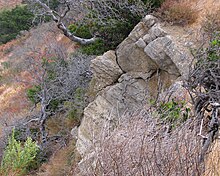Vaqueros sandstone
| Vaqueros Formation Stratigraphic range: upper Oligocene, lower Miocene |
|
|---|---|

Outcrop of the Vaqueros Formation in Gaviota State Park, California.
|
|
| Type | sedimentary |
| Underlies | Rincon Formation, Monterey Formation |
| Overlies | Sespe Formation, Kreyenhagen Formation |
| Thickness | 0-500+ ft |
| Lithology | |
| Primary | sandstone |
| Location | |
| Region | Coastal California and the Central Valley |
| Country | United States |
| Type section | |
| Named for | Vaquero Canyon, Santa Lucia Mountains |
| Named by | Hamlin (1904) |
The Vaqueros Formation is a sedimentary geologic unit primarily of Upper Oligocene and Lower Miocene age, which is widespread on the California coast and coastal ranges in approximately the southern half of the state. It is predominantly a medium-grained sandstone unit, deposited in a shallow marine environment. Because of its high porosity and nearness to petroleum source rocks, in many places it is an oil-bearing unit, wherever it has been configured into structural or stratigraphic traps by folding and faulting. Being resistant to erosion, it forms dramatic outcrops in the coastal mountains. Its color ranges from grayish-green to light gray when freshly broken, and it weathers to a light brown or buff color.
The type locality of the Vaqueros is from Vaqueros Canyon in the Santa Lucia Mountains, about eight miles southwest of Greenfield. The formation was first described by Homer Hamlin in 1904, as part of a report on the water resources of the Salinas Valley.
The sandstone unit consists of well-sorted grains, averaging medium-size, typically quartz and feldspar with some black flecks, and in form it ranges from cross-bedded to massive and thick-bedded. Occasionally it contains pebbles, especially near its base where it sits on the red non-marine Sespe Formation. Some fossils – including mollusks and barnacles – can be found in the Vaqueros, also near the base of the unit where the depositional environment was nearest shore.
The unit was deposited by runoff from highlands to the east into a shallow, warm marine environment, as the ocean transgressed on the subsiding floodplain containing the Sespe in the late Oligocene age, between 26 to 28 Ma (million years before present) to 24 to 25 Ma. As the land continued to subside, the ocean depth increased with a corresponding drop in grain size in higher strata. The topmost part of the Vaqueros contains interbedded mudstones, silstones, and fine-grained sandstones, representing this shift. The unit above the Vaqueros, the Rincon Formation, consists of deepwater shales.
...
Wikipedia
